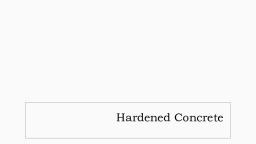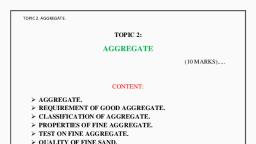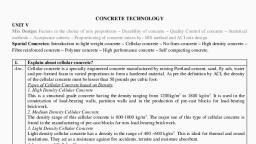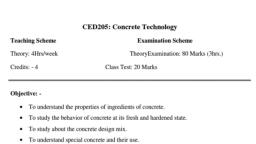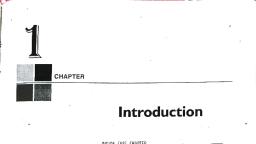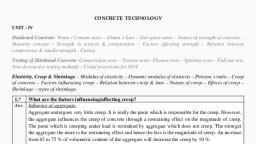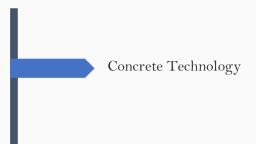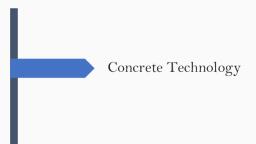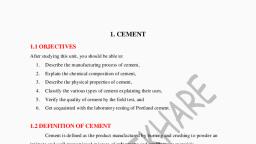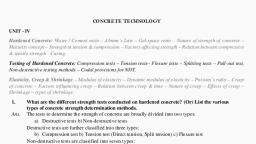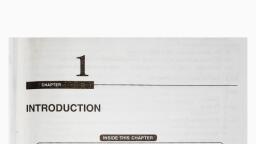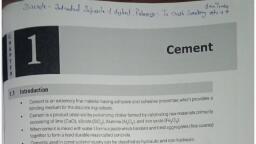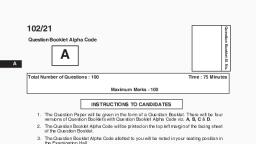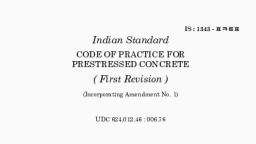Page 1 :
CONCRETE MIX DESIGN
Page 2 :
INTRODUCTION, •, , Concrete is obtained by mixing cement, fine aggregate,, coarse, , aggregate,, , water, , and, , admixtures, , in, , required, , proportions. The mixture when placed in forms and allowed to, cure becomes hard like stone., , •, , The hardening is caused by chemical action between, water and the cement due to which concrete grows stronger, with age., , •, , It is the most widely-used man-made construction material, in the world., , 2
Page 3 :
CONCRETE MAKING MATERIALS, 1., 2., 3., 4., , Cement, Aggregates, Water, Admixtures, , 3
Page 4 :
CEMENT, • Cement and water forms the ‘active’ component of concrete,, while the inactive group comprises the fine and coarse, aggregates., • The cement and water form a paste that hardens and bonds the, aggregates together., Types of Cement, • Although around 18 types of cements are recognized by BIS,, more commonly used ones are:, 1. Ordinary Portland Cement 33, 43, & 53 grade OPC,, 2. Blended Cements (PPC and PSC)., 3. Sulphate Resisting Cement (SRC),, 4. Low Heat Portland Cement (LHPC),, 5. Colored Cement (White Cement)., 4
Page 5 :
AGGREGATES, ❖ They are cheaper than cement and impart greater volume, stability and durability to concrete., ❖ The main purpose is to provide bulk to the concrete., ❖ Some of the aggregates may be chemically active., CLASSIFICATION, •, •, •, •, , Geological origin – natural and artificial, Size – fine, coarse and all-in, Shape – rounded, irregular, angular, flaky and elongated, Unit weight – normal-weight, heavyweight and lightweight, , 5
Page 6 :
WATER, ✓ The most important and least expensive ingredient of concrete., , ✓ One part of the water is used in the hydration of cement to form the, binding matrix., ✓ The remaining water affords lubrication and workability to the, concrete., ✓ Water-cement ratio depends on the grade of concrete, its, workability, durability, nature and type of aggregates etc., ✓ Potable water is ideal for concreting., ✓ Seawater may be used in PCC., , 6
Page 7 :
ADMIXTURES, • Added to the concrete immediately or during mixing to modify, , its properties in the fresh or hardened state., Types:, , o Accelerators - speed up the initial set of concrete., o Retarders – delay the setting time of concrete mix., o Plasticizers and Super-plasticizers - water reducers., o Air entraining admixtures, , 7
Page 8 :
TYPES OF CONCRETE MIXES, 1., , NOMINAL MIX, , Mixes of fixed proportions, IS:456-2000 permits nominal mixes, for concretes of strength M20 or lower, , 2., , DESIGN MIX, Designed on the basis of requirements of the concrete in, fresh and hardened states., , 8
Page 9 :
TRIAL MIXES, Prepared to verify whether the Design Mix would perform as, per the assumptions. If appreciable variation exists, the, available alternatives are:, , 1. directly employ the trial mix proportions at the site, 2. modify the trial mix proportions on the basis of intuition and, employ the revised proportions at the site, 3. prepare further trial mixes incorporating changes in the, , proportions based on the feedback generated from the, previous mix., , 9
Page 10 :
CONCRETE MIX DESIGN, DEFINITION, , “ Mix Design is the science of determining the relative, proportions of the ingredients of concrete to achieve the, desired properties in the most economical way.”, , 10
Page 11 :
MEANING, “To find the proportion of ingredients to, have the required properties with minimum, cost”, The Various ingredients are, •, CEMENT, FINE AGG, •, AGGREGATE, COARSE AGG, •, WATER, •, ADDITIVES/ADMIXTURES
Page 12 :
definition, ❖, , Proportioning of a concrete mix consists of, determining the relative amounts of materials, which will produce a concrete of desired, workability of the fresh concrete, and the, , desired strength, consistency of volume,, durability, and economy in the hardened, concrete., ❖, , These proportions may be determined either by, calculations making use of data related to, materials properties.
Page 13 :
PRINCIPLES OF MIX DESIGN, 1, , The environment exposure condition for the structure, , 2, , The grade of concrete, their characteristic strength’s and standard, deviations, , 3, , The type of cement, , 4, , The types and sizes of aggregates and their sources of supply, , 5, , The nominal maximum sizes of aggregates, , 6, , Maximum and minimum cement content in kg/m3, , 7, , Water cement ratio, , 8, , The degree of workability of concrete based on placing conditions, 13
Page 14 :
9, , Air content inclusive of entrained air, , 10 The maximum/minimum density of concrete, 11 The maximum/minimum temperature of fresh concrete, 12 Type of water available for mixing and curing, 13 The source of water and the impurities present in it., , 14
Page 15 :
Concrete Mixing and Proportioning, • 1. Proportioning: Goal is to achieve mix with, • Adequate strength, • Proper workability for placement, • Low cost, – Low Cost:, • Minimize amount of cement, • Good gradation of aggregates (decreases voids, and cement paste required), 15
Page 16 :
Concrete Mixing and Proportioning, – Water-Cement Ratio (W/C), • Increased W/C: Improves plasticity and fluidity, of the mix., • Increased W/C: Results in decreased strength, due to larger volume of voids in cement paste, due to free water., , 16
Page 17 :
Concrete Mixing and Proportioning, – Water-Cement Ratio (W/C) (cont..), • Complete hydration of cement requires W/C ~, 0.25., • Need water to wet aggregate surfaces, provide, mobility of water during hydration and to, provide workability., • Typical W/C = 0.40-0.60, , 17
Page 18 :
REQUREMENTS, In the design of concrete mixes, three, principal requirements for concrete are of, importance:, ❑ Quality, ❑ Workability, ❑ Economy
Page 19 :
Concrete Mixing and Proportioning, • Quality of concrete is measured by its strength and, durability., The principal factors affecting the, strength of concrete , assuming a sound aggregates,, W/C ratio, and the extent to which hydration has, progressed., • Durability of concrete is the ability of the concrete, to resist disintegration due to freezing and thawing, and chemical attack., , 19
Page 20 :
Concrete Mixing and Proportioning, • Workability of concrete may be defined as a, composite characteristic indicative of the ease, with which the mass of plastic material may, deposited in its final place without segregation, during placement, and its ability to conform to, fine forming detail., , 20
Page 21 :
Concrete Mixing and Proportioning, • Economy takes into account effective use of, materials, effective operation, and ease of handling., The cost of producing good quality concrete is an, important consideration in the overall cost of the, construction project., , 21
Page 22 :
•, , Concrete Mixing and Proportioning, The influence of ingredients on properties of, concrete., , 22
Page 23 :
REASONS FOR DESIGN, ▪ For high strength concrete, it is necessary to, design, , ▪ To get confidence for the strength, ▪ To save the cement, so that cost can be, reduced, shrinkage cracks can be reduced, , ▪ For Special concretes, 23
Page 24 :
TYPES OF CONCRETE, •, •, •, •, •, •, •, •, •, •, •, , Ordinary Concrete, High Strength Concrete, Architectural Concrete, Light Weight Concrete, Mass Concrete, Pumped Concrete, Vacuum Concrete, Plum Concrete, No-Fines Concrete, Grouted Concrete, Fly Ash Concrete, , •, •, •, •, •, •, •, •, , Gap Graded Concrete, High Density Concrete, Polymer Concrete, High Flexural Strength, Concrete, High Creep Strength, Concrete, High Fatigue Strength, Concrete, High Abrasive Strength, Concrete, Fire Resistant Concrete, 24
Page 25 :
FACTORS AFFECTING MIX DESIGN, •, •, •, •, •, •, , Cost, Strength, Quality Control, Durability, Workability, Max Size of, Aggregate, , •, •, •, •, •, •, , Types of Aggregate, Grading of Aggregate, Shape of Aggregate, Type of Cement, Quality of Cement, Aggregate/cement, ratio, , 25
Page 26 :
PROCESS OF MIX DESIGN, CONCRTE MIX, , MINIMUM STRENGTH REQUIRED, , TARGET MEAN STRENGTH, (Quality Control), , W/C, MSA, , GRADING, , WATER, , W/C, , Agg/Cement, 26, , MIX PROPORTIONS
Page 27 :
VARIABLES IN PROPORTIONING, • Water/Cement Ratio, , • Cement –Aggregate Ratio, • Gradation of Aggregate, , • Consistency, , 27
Page 28 :
VARIABLES IN PROPORTIONING, • The effort in proportioning is “to use a minimum, amount of paste( and therefore cement) that will, lubricate the mass while fresh and after, hardening will bind the aggregate particles, together and fill the space between them”., • Any excess of paste involves greater cost,, greater drying shrinkage, permeability, less, durability., • This is minimized by minimizing the voids by, good gradation, 28
Page 29 :
Concept of Mix design, • Strength= f(W/C ratio), , • Workability= f(Agg/Water), • Cost= f(Agg/Cement), , 29
Page 30 :
DURABILITY, “the resistance to weathering action due to environmental, , conditions such as changes in temperature and humidity,, chemical attack, abrasion, frost and fire.”, , 30
Page 31 :
31
Page 32 :
Durability Criteria: Mild Exposure Conditions, , 32
Page 33 :
Statistical Quality Control of Concrete, , 33
Page 34 :
34
Page 35 :
35
Page 36 :
36
Page 37 :
37
Page 38 :
38
Page 39 :
Concrete Strength Acceptance Criteria, IS:456-2000, • Strength of concrete is commonly considered its, most valuable property, although in many, practical cases, other characteristics, such as, durability and permeability, may in fact be more, important., • However, the strength of concrete is almost, invariably a vital element of structural design, and is specified for compliance purposes., , 39
Page 40 :
The minimum frequency of sampling of concrete of each, grade shall be in accordance with the following:, , 40
Page 41 :
ACCEPTANCE CRITERIA, (A) Compressive strength, The concrete shall be deemed to comply with the strength, requirement when both the following conditions are met:, , a) The mean strength determined from any group of four, non-overlapping consecutive test results, complies with the, appropriate limits col. 2 of Table11.29., b) Any individual test result complies with the appropriate, limits in col. 3 Table 11.29, 41
Page 42 :
• (B) Flexural strength, When both the following conditions are met, the concrete, complies with the specified flexural strength., a) The mean strength determine from any group of four, consecutive test results exceed the specified characteristic, strength by at least 0.3 N/mm2, b) The strength determined from any test result is not less, than specified characteristic strength less 0.3 N/mm2, , 42
Page 43 :
• Three test specimens shall be made for each sample for, testing at 28 days. Additional specimens may be, required for 7 days strength. In all the cases 28 days, strength shall alone be the criterion for acceptance or, rejection of the concrete., • The test results of the sample shall be the average of the, strength of three specimens. The individual variation, should not be more than +15 percent of the average., If more, the test results of the sample are invalid., , 43
Page 44 :
44
Page 45 :
Example 1: Grade of concrete : M25, Laboratory design mean target strength for, good quality control: 25 + (1.65 x 4)= 31.6 N/mm2 at 28 days age, In all the case average of three 150 mm cubes shall be taken., In one shifts 4 m3 foundation concrete was done., , 45
Page 46 :
46
Page 47 :
47
Page 48 :
• A, sample, consist, of, three, cubes/specimens . It is better for the same, concrete sample cast more than three, cubes, so that any defective cube should, not be tested or any doubt full test result, due to testing may be rejected and not, included in the average of three cubes., , 48
Page 49 :
METHODS OF CONCRETE MIX DESIGN, 1. American Concrete Institute Committee 211 method, 2. Bureau of Indian Standards Recommended method IS 10262, , 49
Page 50 :
American Concrete Institute Method of Mix Design, (a) Data to be collected :, (i ) Fineness modulus of selected F.A., (ii ) Unit weight of dry rodded coarse aggregate., (iii ) Sp. gravity of coarse and fine aggregates in SSD condition, (iv ) Absorption characteristics of both coarse and fine, aggregates., (v ) Specific gravity of cement., (b) From the minimum strength specified, estimate the average, design strength by using standard deviation., (c) Find the water/cement ratio from the strength and durability, points of view. Adopt the lower value., 50
Page 51 :
(d) Decide the maximum size of aggregate to be used. Generally, for RCC work 20 mm and pre-stressed concrete 10 mm size are, used., , (e) Decide workability in terms of slump for the given job., (f ) The total water in kg/m3 of concrete is determined,, corresponding to the selected slump and selected maximum, size of aggregate., (g ) Cement content is computed by dividing the total water, content by the water/cement ratio., (h) Select the bulk volume of dry rodded coarse aggregate per unit, volume of concrete, for the particular maximum size of coarse, aggregate and fineness modulus of fine aggregate., 51
Page 52 :
( j ) The weight of C.A. per cubic meter of concrete is calculated by, multiplying the bulk volume with bulk density., (k ) The solid volume of coarse aggregate in one cubic meter of, concrete is calculated by knowing the specific gravity of C.A., (l ) Similarly the solid volume of cement, water and volume of air is, calculated in one cubic meter of concrete., (m) The solid volume of FA is computed by subtracting from the, total volume of concrete the solid volume of cement, CA, water, and entrapped air., (n) Weight of fine aggregate is calculated by multiplying the solid, volume of fine aggregate by specific gravity of F.A., , 52
Page 53 :
ACI METHOD: DESIGN EXAMPLE, 1 Design a concrete mix for the construction of an elevated water, tank. The specified design strength of concrete (characteristic, strength) is 30 MPa at 28 days measured on standard cylinders., Standard deviation can be taken as 4 MPa. The specific gravity, of FA and C.A. are 2.65 and 2.7 respectively. The dry rodded, bulk density of C.A. is 1600 kg/m3, and fineness modulus of FA, is 2.80. Ordinary Portland cement (Type I) will be used. A slump, of 50 mm is necessary. C.A. is found to be absorptive to the, , extent of 1% and free surface moisture in sand is found to be 2, per cent. Assume any other essential data., , 53
Page 54 :
1 Mean Cylinder Compressive Strength, Assuming 5 per cent of results are allowed to fall below, specified design strength,, The mean strength,, fm= fmin + ks, = 30 + 1.64 x 4, = 36.5 MPa, , 2, , Water/cement ratio, ❖, ❖, , Strength criteria, Durability criteria, , 54
Page 55 :
Strength Criteria, , 55
Page 56 :
Durability Criteria, , 56
Page 57 :
3, , Mixing Water Content, , Slump = 50 mm, Maximum size of aggregate = 20 mm, Concrete is non air-entrained, , 57
Page 58 :
58
Page 59 :
The mixing water content is 185 kg/m3 of concrete, , The approximate entrapped air content is 2%., , The required cement content =185/0.47, = 394 kg/m3, , 59
Page 60 :
4, , Bulk Volume of C.A., , Maximum size of C.A = 20mm, Fineness Modulus of F.A. = 2.80, , Find the dry rodded bulk volume of C.A., , 60
Page 61 :
61
Page 62 :
The dry rodded bulk volume of C.A. = 0.62 per unit volume of, concrete, , The weight of C.A. = 0.62 x 1600, = 992 kg/m3, , 62
Page 63 :
5, , The first estimate of density of fresh concrete = 2355 kg/m3, , 63
Page 64 :
6, , Weight of FA, , The weight of all the known ingredients of, concrete, Weight of water, , = 185 kg/m3, , Weight of cement = 394 kg/m3, , Weight of C.A., , = 992 kg/m3, , Weight of F.A., , = 2355 – (185 + 394 + 992), = 784 kg/m3, , 64
Page 65 :
Alternatively, the weight of F.A. can be determined by the more, accurate absolute volume method, Absolute Volume = weight/(1000ρ), , m3, , 65
Page 66 :
Total absolute volume = 697 x 103 cm3, , Absolute volume of F.A. = (1000 – 697) x 103, = 303 x 103, Weight of FA = 303 x 2.65, , = 803 kg/m3, , 66
Page 67 :
7 Estimated quantities of materials per cubic meter of, concrete are:, , Cement = 394 kg, F.A = 803 kg, C.A = 992 kg, Water = 185 kg, , 67
Page 68 :
8, , Proportions, , C : F.A : C.A : water, , 394 : 803 : 992 : 185, 1 : 2.04 : 2.52 : 0.47, Weight of materials for one bag mix, in kg = 50 : 102 : 126 : 23.5, , 68
Page 69 :
9 The above quantities is on the basis that both F.A, and C.A are in saturated and surface dry condition, (SSD conditions)., , FA has surface moisture of 2%, Total free surface moisture in FA = (2/100 x 803), , = 16.06 kg/m3, Weight of F.A in field condition = 803 + 16.06 = 819.06 kg/m3, , 69
Page 70 :
C.A absorbs 1% water, Quantity of water absorbed by C.A. = (1/100 x 992) = 9.92 kg/m3, , Weight of C.A in field condition = 992 – 9.92, = 982 kg/m3, Change in Water Content, , Water contributed by F.A, Water absorbed by C.A., Extra water contributed by aggs., Total water content, , = 16.06 kg, = 9.92 kg, = 16.06 – 9.92 = 6.14 kg, = 185.00 – 6.14, = 179 kg/m3, , 70
Page 71 :
Quantities of materials to be used in field, corrected for, free surface moisture in F.A and absorption characteristic, of C.A, , Cement, , = 394 kg/m3, , F.A., , = 819 kg/m3, , C.A., , = 982 kg/m3, , Water, , = 179 kg/m3, , Field density of fresh concrete = 2374, kg/m3, , 71
Page 72 :
2. A mix with a mean 28-day compressive strength of 35 MPa and, a slump of 50 mm is required, using OPC. The maximum size, of well shaped, angular aggregate is 20mm, its bulk density is, 1600 kg/m3 and its specific gravity is 2.64. The available fine, aggregate has a fineness modulus of 2.60 and a specific, gravity of 2.58. No air-entrainment is required., , Water/Cement ratio, , As durability criteria is not, mentioned, consider strength alone, , 72
Page 73 :
Strength Criteria, , 73
Page 74 :
Water/cement ratio =0.48, Slump = 50 mm, Max size of aggregate = 20 mm, , Determine water content, , 74
Page 75 :
75
Page 76 :
76
Page 77 :
Composition of concrete (kg/m3), , Water, , =, , 185, , Cement, , =, , 386, , CA, , =, , 1020, , FA, , =, , 738, , Density of Concrete, , =, , 2329 (kg/m3), , 77
Page 78 :
BIS RECOMMENDED MIX DESIGN METHOD, The BIS recommended mix design procedure is covered in IS, , 10262-82., In line with IS 456-2000, the first revision IS 10262-2009 was, published, to accommodate some of the following changes:, , • Increase in strength of cement, • Express workability in terms of slump, rather than the, compacting factor, , • Extend the W/C ratio v/s compressive strength graph, , 78
Page 79 :
Modifications in IS 10262-2009, , 79
Page 80 :
MIX DESIGN BASED ON IS RECOMMENDATIONS, Based on IS 10262:1982, Procedure:, 1. Target mean strength for mix design:, , fck* = fck + tS, where fck = characteristic compressive strength at 28 days, S = standard deviation, t = a statistical value depending on the risk factor., , 80
Page 81 :
81
Page 82 :
82
Page 83 :
2. Selection of Water/Cement ratio, , 83
Page 84 :
3. Estimation of Entrapped Air, , 84
Page 85 :
4. Selection of Water Content and Fine to Total Aggregate ratio, , 85
Page 86 :
86
Page 87 :
5. Calculation of Cement Content:, cement by mass = Water content/Water cement ratio, To be checked against the minimum cement content for the requirement, of durability and the greater of the two values to be adopted., , 87
Page 88 :
6. Calculation of aggregate content:, , 88
Page 89 :
7. Actual quantities required for mix, Adjust the mix for deviations from assumed conditions, , 8. Check the calculated mix proportions, , 89
Page 90 :
DESIGN EXAMPLE: BIS RECOMMENDED METHOD, , Grade M20, (a ) Design stipulations, (i ) Characteristic compressive strength, required in the field at 28 days - 20 MPa, (ii ) Maximum size of aggregate - 20 mm (angular), (iii ) Degree of workability - 0.90 compacting factor, (iv ) Degree of quality control - Good, (v ) Type of Exposure - Mild, , 90
Page 91 :
(b) Test data for Materials, (i ) Specific gravity of cement - 3.15, (ii ) Compressive strength of cement at 7 days - Satisfies the, requirement of IS: 269–1989, (iii ), , 1. Specific gravity of coarse aggregates - 2.60, 2. Specific gravity of fine aggregates - 2.60, , (iv ) Water absorption:, 1. Coarse aggregate - 0.50%, 2. Fine aggregate - 1.0%, (v ) Free (surface) moisture:, 1. Coarse aggregate - Nil, 2. Fine aggregate - 2.0%, , 91
Page 93 :
2. Selection of Water/Cement Ratio, , 93
Page 94 :
Durability Criteria: Mild Exposure Conditions, , 94
Page 95 :
W/C ratio from strength considerations = 0.50, , W/C ratio from durability considerations = 0.55, , Adopt the lower value, , 95
Page 96 :
3. Selection of water and sand content, , 96
Page 97 :
Adjustments in Water and Sand Contents, , 97
Page 98 :
4. Determination of cement content, Water-cement ratio = 0.50, water = 191.6 kg/m3, , Cement = 191.6/0.50 = 383 kg/m3, , Is this satisfactory for ‘mild’ exposure condition?, , 98
Page 99 :
5. Determination of coarse and fine aggregate contents, Specified max. size of aggregate = 20 mm, Corresponding entrapped air = 2%, , fa = 546 kg/m3,, , Ca = 1188 kg/m3, , 99
Page 100 :
Final Mix Proportions, Water, , Cement, , FA, , CA, , 191.6, , 383, , 546, , 1188, , 0.50, , 1, , 1.425, , 3.10, , 100
Page 101 :
IS Method of Proportioning, Concrete Mixes, ◼, ◼, , The IS METHOD, The procedure is as follows:, ◼ Step 1. Calculate Target Mean Strength, ◼ Step 2. Choice of maximum size of aggregate, ◼ Step 3. Estimation of mixing water and air content, ◼ Step 4. Selection of water/cement ratio, ◼ Step 5. Calculation of cement content, ◼ Step 6. Estimation of coarse aggregate content, ◼ Step 7. Estimation of Fine Aggregate Content, ◼ Step 8. Adjustments for Aggregate Moisture, ◼ Step 9. Trial Batch Adjustments, 101
Page 102 :
IS METHOD OF CONCRETE MIX DESIGN, , , , IS:10262-2009
Page 103 :
Data required for Proportioning, , , , , , , , Grade Designation, Type of Cement, Maximum Nominal size of, Aggregate, Minimum Cement, Content, Maximum w/c ratio, Workability in terms of, Slump, , Exposure conditions, Method of placing, Type of aggregate, Maximum cement content, Test data of Materials, Admixture type and, , condition of use if any
Page 104 :
Mix Proportioning, , Target Strength, , Check for, Min. Cement, , Selection of w/c Ratio, , Check for, max w/c, , Selection of Water content, , Correction, for Slump, , Calculation Of Cement, Content, , Admixture, Correction(if, any), , Proportion Of CA & FA, , Correction, for w/c, , Mix Calculations, , Correction for, Placement, Type
Page 105 :
Mix Proportioning Procedure IS:10262-2009, 1., 2., 3., 4., 5., 6., 7., 8., , Target strength for mix proportioning, Selection of w/ c ratio, Selection of water content, Corrections in water content, Calculation of cement content, Proportion of volume of coarse aggregate and fine aggregate, content, Corrections, Mix calculations
Page 106 :
Numerical Example, Design stipulations for proportioning, , , Grade designation, , : M20, , , , Type of cement, , : OPC 43 grade, IS 8112, , , , Max. nominal size of agg., , : 20 mm, , , , Minimum cement content, , : 320 kg/m3, , , , Maximum water cement ratio, , : 0.55, , Workability, , : 75 mm (slump), , Exposure condition, , : Mild, , , , Degree of supervision, , : Good, , , , Type of agg., , : Crushed angular agg., , Maximum cément content, , : 450 kg/m3, , Chemical admixture, , : Not used, , , , , ,
Page 107 :
Test data for materials, Cement used, Specific gravity of cement, Specific gravity of, , : OPC 43 grade, : 3.15, , , , Coarse aggregate, , : 2.68, , , , Fine aggregate, , : 2.65, , Water absorption, , , Coarse aggregate, , : 0.6 percent, , , , Fine aggregate, , :1.0 %, , Free (surface) moisture, , , Coarse aggregate, , : Nil, , , , Fine aggregate, , : Nil, , Sieve analysis, Coarse aggregate, Fine aggregate, , : Conforming to Table 2 of IS 383, : Conforming to Zone I of IS 383
Page 108 :
1. Target strength for Mix Proportioning, Target strength = f’ck= fck +ks, From Table 1, standard deviation, s = 4 N/mm2, , Therefore target strength, = 20+1.65 x4, = 26.60 N/mm2
Page 109 :
2. Selection of w/ c ratio, From Table 5 of IS 456:2000,, Maximum w/c ratio = 0.55 (Mild exposure), Based on experience adopt water cement ratio as 0.50, 0.5 < 0.55, hence ok
Page 110 :
3. Selection of water content, From Table 2, IS 10262:2009, , Maximum water content = 186 litres, , (for 25mm – 50 mm slump range and for 20 mm aggregates)
Page 111 :
4.Corrections in Water content, As per IS10262:2009 Clause 4.2,, For workability other than 25-50mm the required water content can be, established by trial or increasing 3% for every additional 25mm slump, and considering correction for admixture if any., Estimated water content for 75 mm slump, = 186 + 3/100 x 186, = 191.6 litres
Page 112 :
5.Calculation of cement content, , Water cement ratio, , = 0.50, , Cement content, , = 191.6/0.5, = 383 kg/m3 >320 kg/m3(given)
Page 113 :
From Table 5 of IS 456,, Minimum cement content for mild exposure condition, = 300 kg/m3, Hence OK
Page 114 :
6.Proportion of volume of Coarse aggregate, and Fine aggregate content, From Table 3, IS 10262:2009, Volume of coarse aggregate corresponding to 20 mm size aggregate and fine, aggregate (Zone I) for water-cement ratio of 0.50, , = 0.60
Page 115 :
7.Mix calculations, The mix calculations per unit volume of concrete shall be as follows, 1) Volume of concrete, , = 1 m3, , 2) Volume of cement, , = mass of cement/sp. gravity of cement x 1/1000, = [383.16/3.15] x [1/1000], = 0.122 m3, , 3) Volume of water, , = [192/1] x [1/1000], = 0.192 m3
Page 116 :
4)Volume of all in aggregates (e) = a – (b + c), = 1 – (0.122 + 0.192), , = 0.686 m3, 5) Volume and weight of coarse aggregates, Volume, , = 0.686 x 0.6 = 0.412 m3, , Weight, , = Volume of CA (0.412 m3) x sp. gravity(2.68) of CA, = 1103 kg, , 6) Volume and weight of fine aggregates, = e x Volume of FA (0.274 m3) x sp. gravity of FA, Volume, , = 0.686 x 0.4 = 0.274 m3, , Weight, , = Vol. of FA (0.274 m3) x sp. gravity(2.65) of FA x 1000, , = 727 kg
Page 117 :
8.Mix proportions for Trial Number 1, Cement, , = 383 kg/m3, , Water, , = 191.6 kg/m3, , Fine aggregate, , = 727 kg/m3, , Coarse aggregates, , = 1103 kg/m3, , Water cement ratio, , = 0.50, , Yield, , = 2404.6 kg
Page 118 :
Tutorial 5 Question 1 :, 1, , Grade Designation, , 2, , Type of Cement, , 3, , Maximum Nominal Aggregate Size 20 mm, , 4, , Minimum Cement Content, , 300 kg/m3, , 5, , Maximum Water Cement Ratio, , 0.5, , 6, , Workability, , 75-100 mm (Slump), , 7, , Exposure Condition, , Moderate, , 8, , Method of Concrete Placing, , Pumping, , 9, , Degree of Supervision, , Good, , 10 Type of Aggregate, , M25, OPC 53 grade confirming to IS12269-1987, , Crushed Angular Aggregate
Page 119 :
Test Data for Materials, 1, , Cement Used, , OPC 53 grade, , 2, , Sp. Gravity of Cement, , 3.11, , 3, , Sp. Gravity of Water, , 1, , 4, , Sp. Gravity of 20 mm Aggregate, , 2.72, , 5, , Sp. Gravity of Sand, , 2.69, , 6, , Water Absorption of 20 mm Aggregate 0.10%, , 7, , Water Absorption of Sand, , 0.50%, , 8, , Free (Surface) Moisture of 20 mm, Aggregate, , nil, , 9, , Free (Surface) Moisture of Sand, , nil, , 10, , Sieve Analysis of Coarse Aggregates, , Conforming to IS 383, , 11, , Sieve Analysis of Fine Aggregates, , Conforming to IS 383 specifications of Zone-III
Page 120 :
SPECIAL CONCRETES
Page 121 :
I. LIGHT WEIGHT CONCRETE, •, , Lightweight concrete mixture is made with a lightweight coarse, aggregate and sometimes a portion or entire fine aggregates may be, lightweight instead of normal aggregates., , •, , Density of this concrete varies from 300 to 1900 kg/m3., , •, , Lightweight aggregates used in structural lightweight concrete are, typically expanded shale, clay or slate materials that have been fired, in a rotary kiln to develop a porous structure., , •, , Other products such as air-cooled blast furnace slag are also used.
Page 123 :
LIGHT WEIGHT CONCRETE, •, , It is convenient to classify the various types of lightweight concrete, by their method of production., , •, , These are:, , 1., , Lightweight aggregate concrete., , 2., , Aerated or Cellular or Foamed or Gas concrete., , 3., , No-fines concrete
Page 124 :
1. LIGHT WEIGHT AGGREGATE, CONCRETE, •, , Lightweight aggregate concrete is prepared by using lightweight, aggregate or low density aggregate such as volcanic pumice, clay,, slate, shale, scoria, volcanic tuff and pellite., , •, , Density of light weight aggregate concrete varies between 500 – 1850, kg/m3.
Page 126 :
1. LIGHT WEIGHT AGGREGATE, CONCRETE, Uses Of Lightweight Aggregate Concrete:, 1. Lightweight aggregate concrete can be used for casting structural steel to, protect it against fire and corrosion. It can also help in covering architectural, purposes., 2. It can be used for heat insulation purposes on the roofs., 3. It can be used to insulate water pipes., 4. Lightweight aggregate concrete can be used for the construction of, partition walls and panel walls in frame structures., , 5. It can be used to create general insulation of walls., 6. It is also used to get surface rendered for external walls of small houses., 7. It can be used for reinforced concrete
Page 127 :
2. AERATED CONCRETE, •, , Concrete prepared by introducing large voids within the concrete or, mortar mass., , •, , These voids should be clearly distinguished from the extremely fine, voids produced by air entrainment., , •, , This type of concrete is also known as cellular, foamed or gas, concrete., , •, , Density of Aerated Concrete varies between 300 – 800 kg/m3.
Page 128 :
2. AERATED CONCRETE, There are several ways in which aerated concrete can be manufactured:, (a) By the formation of gas by chemical reaction within the mass during, liquid or plastic state., (b) By mixing preformed stable foam with the slurry., (c) By using finely powdered metal (usually aluminum powder) with the, slurry and made to react with the calcium hydroxide liberated during the, hydration process, to give out large quantity of hydrogen gas. This hydrogen, gas when contained in the slurry mix, gives the cellular structure., Powdered zinc may also be added in place of aluminum powder.
Page 130 :
2. AERATED CONCRETE, The aerated concrete usually is used for the following purposes:, 1. Due to its low thermal conductivity and weight, mostly it is used for heat, insulation purposes., , 2. As it offers better fire resistance than ordinary concrete, it is used for fire, proofing., 3. Structurally aerated concrete is used mostly in the form of precast, members or autoclaved blocks. It can also be used for floor construction in, place of hollow tile floor.
Page 131 :
3. NO - FINES CONCRETE, •, , No-Fines Concrete is a lightweight concrete made up of only coarse, aggregate, cement and water by omitting fines (sand or fine aggregates), from normal concrete., , •, , Very often only single sized coarse aggregate, of size passing through 20, mm retained on 10mm is used., , •, , The single sized aggregates make a good no-fines concrete, which in, addition to having large voids and hence light in weight, also offers, architecturally attractive look., , •, , No-fines concrete is generally made with the aggregate/cement ratio from, , 6 : 1 to 10 :1 and density varies in between 1600 – 1900 kg/m3.
Page 132 :
3. NO - FINES CONCRETE, •, , The principal applications of no-fines concrete are for load-bearing, cast-in-place external walls of single story and multi story housing,, small retaining walls and as a damp proofing subbase material for, concrete floors cast on grade.
Page 133 :
II. HIGH DENSITY CONCRETE, •, , As the name suggests, the density of this concrete varies from 3360, kg/m3 to 3840 kg/m3, whereas the density of normal concrete is of the, order of 2400 kg/m3., , •, , The density of light weight concrete is about 1900 kg/m3 and that of, normal concrete about 2400 kg/m3., , •, , Thus the density of high density concrete is about 50% more than the, density of conventional concrete., , •, , However this concrete can be produced of density upto 5200 kg/m3 using, iron as both fine and coarse aggregate.
Page 134 :
II. HIGH DENSITY CONCRETE, •, , High density concrete is also known as “Heavy weight concrete”., , •, , High density concrete is mainly used for the purpose of radiation, shielding, for counterweights and other uses where high density is, required.
Page 135 :
II. HIGH DENSITY CONCRETE, •, , Main Components: Cement, Water, Aggregates, Admixtures, , •, , The high density concrete has a better shielding property, so that it, can protect harmful radiations like X-rays, gamma rays, and, neutrons., , •, , High density aggregates are used to achieve heavy weight concrete., , •, , Some of the high density aggregates are barite, Ferro-phosphorus,, limonite, hematite, ilmenite, magnetite, goethite, steel punching, and, steel shots.
Page 136 :
III. FIBER REINFORCED CONCRETE, •, , Fiber Reinforced Concrete is a composite material consisting of fibrous, material which increases its structural integrity., , •, , It includes mixtures of cement, mortar or concrete and discontinuous,, discrete, uniformly dispersed suitable fibers., , •, , Fiber is a small piece of reinforcing material possessing certain, characteristics properties. The, fiber is often described by a, convenient parameter called “Aspect Ratio”., , •, , The Aspect Ratio of the fiber is the ratio of its length, diameter. Typical aspect ratio ranges from 30 to 150., , to its
Page 137 :
III. FIBER REINFORCED CONCRETE, Type of fibers:, , 1., , Steel Fibers, , 2., , Polypropylene Fibers, , 3., , Glass Fibers, , 4., , Polyester Fibers, , 5., , Carbon Fibers, , 6., , Natural fibers (Coir fibre, Cotton fibre, Sisal fibre, Jute fibre and, Wool fibre)
Page 138 :
III. FIBER REINFORCED CONCRETE, Advantages:, •, , Fibers reinforced concrete may be useful where high tensile strength and, reduced cracking are desirable., , •, , It improves the impact strength of concrete, limits the crack growth and, leads to a greater strain capacity of the composite material, , •, , Adding fibers to the concrete will improve its freeze-thaw resistance and, help keep the concrete strong and attractive for extended periods., , •, , Improve mix cohesion, improving pumpability over long distances, , •, , Increase resistance to plastic shrinkage during curing, , •, , Minimizes steel reinforcement requirements, , •, , Controls the crack widths tightly, thus improving durability, , •, , Reduces segregation and bleed-water
Page 139 :
STEEL FIBER REINFORCED CONCRETE, •, , Steel fiber is a metal reinforcement., , •, , A certain amount of steel fiber in concrete can cause, qualitative changes in concrete’s physical property., , •, , It can greatly increase resistance to cracking, impact,, fatigue, and bending, tenacity, durability, and others., , •, , For improving long-term behavior, enhancing, strength, toughness, and stress resistance, SFRC is, being used in structures such as flooring, housing,, precast, bridges, tunnelling, heavy-duty pavement,, and mining.
Page 140 :
POLYPROPYLENE FIBER REINFORCED, CONCRETE, •, , Polypropylene fiber reinforced concrete is also, known as polypropene or PP., , •, , It is a synthetic fiber, transformed from, propylene, and used in a variety of applications., , •, , These fibers are usually used in concrete to, control cracking due to plastic shrinkage and, drying shrinkage., , •, , They also reduce the permeability of concrete, and thus reduce the bleeding of water., , •, , Polypropylene fiber belongs to the group of, polyolefins and is partially crystalline and nonpolar.
Page 141 :
GLASS FIBER REINFORCED CONCRETE, •, , Glass fiber reinforced concrete is a material, consisting of numerous extremely fine fibers of, glass., , •, , Glass fibers are used as reinforcing agents for, many polymer products; to form a very strong and, relatively lightweight fiber-reinforced polymer (FRP), composite material called glass-reinforced plastic, (GRP), also popularly known as “fiberglass”., , •, , This material contains little or no air or gas, is, denser, and is a much poorer thermal insulator, than is glass wool., •
Page 142 :
POLYESTER FIBERS, •, , Polyester fibers are used in fiber-reinforced, concrete for industrial and warehouse floors,, pavements, and, overlays, and, precast, products., , •, , Polyester micro- and macro-fibers are used in, concrete to provide superior resistance to the, formation of plastic shrinkage cracks., •
Page 143 :
CARBON FIBERS, •, , Carbon fibers are fibers about 5–10, micrometres in diameter and composed, mostly of carbon atoms., , •, , Carbon fibers have several advantages, including high stiffness, high tensile strength,, low weight, high chemical resistance, hightemperature tolerance and low thermal, expansion., , •, , Carbon fibers are also composited with other, materials, such as graphite, to form reinforced, carbon composites, which have a very high, heat tolerance.
Page 144 :
NATURAL FIBERS, •, , The natural fiber is directly obtainable from an, animal, vegetable, or mineral source and, convertible into nonwoven fabrics such as felt or, paper or, after spinning into yarns, into woven, cloth., , •, , The use of natural fibers in making concrete is, recommended since several types of these fibers, are available locally and are plentiful., , •, , The idea of using such fibers to improve the, strength and durability of brittle materials is not, new; for example, straw and horsehair are used to, make bricks and plaster., , •, , Natural fibers are suitable for reinforcing concrete, and are easily available in developing countries.
Page 145 :
POLYMER CONCRETE, Definition: It is a type of concrete, in which polymers are used as a binding material instead, of cement. The lime-type cement is replaced in this type of concrete. The polymer resin is used, with or without the Portland cement. If the polymer concrete is made only with the polymer, resins, it is known as Polymer Cement Concrete, if the polymer resin is mixed with ordinary, cement, then the mixture is known as Polymer Modified Concrete., Composition of Polymer Concrete: Polymer concrete is prepared from thermosetting resin, and thermoplastic polymers. The use of the thermosetting resin is more adequate, as it is highly, thermal resistant and a wide variety of chemicals. The polymer concrete is composed of, polymer resin and aggregates. The polymer resin acts as the binder, while the aggregate acts as, the compressive stress material. The aggregate of concrete is composed of quartz, silica, granite, pebbles, limestone gravels, and other material of high compressive strength. A successful, aggregate must be of good quality material, clean gravels, dust, and debris free, and dry., These criteria must be fulfilled on all accounts, failing which will put a negative impact on the, binding ability of the concrete., Different types of Polymer/Polymer Resins use in Concrete:, 1. Furan Resins, 2. Acrylics and Styrene-Acrylics, 3. Vinyl Acetate-Ethylene (VAE), 4. Polyvinyl Acetate (PVA), 5. Styrene-Butadiene Resin (SBR), 6. Methyl Methacrylate MMA, 7. Styrene and Polyester Styrene, 8. Methanol, 9. Epoxy Resins, 10. Poly-Urethane Resins (PUR), 11. Urea Formaldehyde Resin and so forth., Preparation of Polymer Concrete: Polymeric resin is added with the aggregate to prepare the, mixture of the concrete. To fill the pores and cracks, the micro-fillers are also employed with, the polymeric resin/concrete. The most used polymers are methacrylate, polyester resin, vinyl, ester resin, epoxy resin, and furan resin. Among these resins, the unsaturated polyester resin is, the most common polymer resin used in concrete. The reason behind the abundant use of, unsaturated polyester resin is its easy availability, low cost, and good mechanical property, and, compressive strength., Properties of Polymer Concrete: The properties of the concrete are dependent upon the, properties of aggregate, mixture, purity and cleanliness, and quality of the polymeric resin, but, here we are discussing only the properties of polymeric resins, and their impact on the cost,, durability, and strength., 1. Using a polymer as a binder instead of cement is more expensive., 2. If compared with the unreinforced Portland concrete, it has greater tensile strength,, because of the strong adhesive property., 3. The compressive strength of the polymer concrete is either similar to or greater than, that of the Portland concrete.
Page 146 :
4. The polymer concrete is much faster curing., 5. The curing of the concrete is automatic, it does not need care, like the pouring of water,, preventing from rain, dust, and heat, etc., 6. It has good adhesive properties, even to the surface of the reinforced structure., 7. It is also much durable in the conditions of rapid freeze and thaw cycles., 8. Polymer Concrete is very low permeable to water and absorptive solutions., 9. Polymer Concrete is resistant to chemicals. It can survive chemical attacks, like that of, sulfate, carbonates, oils, acid, and alkali, etc., 10. Resistant to corrosion., 11. Lighter in weight and less dense than the ordinary cement concrete, thus reducing the, dead weight of the concrete structure., 12. It can be vibrated to fill the pores, voids, and cracks in the structure., 13. The polymer concrete allows the use of “form releasing agents” like Non-Silicone., 14. It is a dielectric/ electric insulator., 15. Polymer concrete can be applied in very thin cross-sections., 16. Polymer concrete does not allow the intrusion of CO2, saving the concrete from, carbonation., Disadvantages of Polymer Concrete:, 1. The cost of polymer concrete is very high as compared to that of conventional concrete., 2. The work of polymer needs high skill and precise work while mixing., 3. The possibility of improper proportioning of two-component material higher, thus the, proper mix design is needed to get even mixing of the concrete material., 4. Working with chemicals and resins used in polymer concrete is risky, therefore, the use, of mask, hand gloves, and other skin protective tools are strictly needed., Use Cases of Polymer Concrete:, The use of polymer concrete is successful in both the new construction and the repair work., The polymer has a great adhesive property, that is why it can be used in the repair work of both, the polymer concrete structure and the ordinary cement concrete structure. Moreover, due to, the low permeability and corrosion resistance, it can be used in swimming pools, water tanks,, sewer structures, drainage channels, and other underwater structures. Polymer concrete is used, in specialized construction projects where there is a need to resistant several types of corrosion, and is supported to have durability i.e. to last-long. It can be used similarly to ordinary concrete., Polymer concrete is used in the followings works,, 1., 2., 3., 4., 5., 6., , Repair to corrosion damaged concrete, Prestressed concrete, Nuclear power plants, Electrical or industrial construction, Marine works, Prefabricated structural components like acid tanks, manholes, drains, highway median, barriers, and so forth., 7. Waterproofing of structures, 8. Sewage works and desalination plants
Page 147 :
SELF COMPACTING, CONCRETE, , 1
Page 148 :
Contents:, Introduction, Materials used for SCC, Requirements of SCC, Different Tests On SCC, Mix Proportioning Of SCC, Advantages and Dis-advantages of SCC, How Economical is SCC…?, Places where it is used, 2
Page 149 :
1. INTRODUCTION:, o Self Compacting Concrete was first developed in Japan, in the year 1980., o Prof. H.Okamura of University of Tokyo, Japan; is mainly, responsible for initiating and initial development of this, concrete and is now regarded as the Father of SCC., o The need for the development of SCC arose from the, skilled labor and man power in Japan during 1980’s., o It is a greatest technological advancement and the most, revolutionary development in concrete technology over, the years, at least from 1980 till date., 3
Page 150 :
Growth and development:, Though SCC was first developed to overcome, the deficiency of the skilled man power,, subsequently it is observed that SCC not only, reduces the requirement of man power, but it, also results in more durable concrete with the, excellent user friendly characteristics., It has a big role to play because of the, sustainable benefits in construction both, quantitatively and qualitatively., It is now used in many countries such as, Canada,Sweden,Netherlands,USA,Austria,, Korea etc., 4
Page 151 :
Mechanism of achieving self compaction, Reduction of, water:binder ratio, Limitation of CA and, it’s maximum size, Addition of mineral, Admixtures, Use of super, Plasticizers and VMA, , High segregation, resistance of, mortar and, concrete., , SELF, COMPACTING, CONCRETE., , High, deformability of, mortar and, concrete, , 5
Page 152 :
Comparison Of SCC Over NC, INGREDIENTS, , NORMAL, CONCRETE, , SELF COMPACTING, CONCRETE, , FINES, , 12%, , 18%, , SAND, , 24%, , 34%, , COARSE, AGGREGATES, , 46%, , 28%, , WATER, , 18%, , 20%, , ADMIXTURE, , -, , 0.01%, , 6
Page 153 :
2. MATERIALS USED FOR SCC:, •, Cement: OPC of 43or 53 grade can be used., • Aggregates:, Agg. Of size ltd. to 20mm., Congested Reinforcement:10 to 12mm, Well graded cubical or rounded aggregates., FA can be either natural or manufactured and, of uniform grade., Particle sizes <0.125mm are considered as, fines, •, Water: It must be of the same quality used for that of RC, or Pre stressed concrete., 7
Page 154 :
2. MATERIALS USED FOR SCC:, • Chemical Admixtures: The new generation super plasticizers, termed termed as poly carboxylated ethers, is particularly used., o, VMA : For stability, o Air Entraining Agents : To improve Freeze-Thaw resistance, o, Retarders : To control setting time, • Mineral Admixtures:, o, GGBS : To improve Rheological Properties., o, Fly ash : To improve the quality and durability., o, Silica Fumes: To improve Mechanical Properties., o, Stone Powder: To increase the powder content., 8
Page 155 :
3.REQUIREMENTS OF SCC:, The main characteristics of SCC are the properties in, the Fresh state. The mixed design is focused on the, ability to flow under it’s own weight without, Vibration (FILLING ABILITY), and to retain homogeneity, (PASSING ABILITY) without segregation (SEGREGATION, RESISTANCE) ., A concrete mix can only be classified as SCC if it has the, above mentioned characteristics., 9
Page 156 :
4. DIFFERENT TESTS ON SCC:, Filling Ability, Tests, , Passing ability, Tests, , Slump Flow Test, , J-Ring Test, , T50cm Slump Flow, , L-Box Test, , V-Funnel Test, , U-Box Test, , Orimet, , Fill-Box Test, , Segregation, resistance Test, V-funnel At T5minutes, GTM Screen, stability Test, , 10
Page 157 :
Slump Flow Test, , 11
Page 158 :
T50 Slump Flow Test, Test, , 12
Page 159 :
V-Funnel Test, , 13
Page 161 :
J-Ring Test, , 15
Page 162 :
L-box Test, , 16
Page 163 :
U-Box Test, , 17
Page 164 :
Fill Box Test, , 18
Page 165 :
V-Funnel Test At T5minutes, , 19
Page 167 :
5. MIX PROPORTIONING OF SCC, CA, , <50%, , Water: Powder, , 0.8 to 1.0, , Total Paste, , 400 to 600 kg/m^3, , Sand Content, , >40% of mortar, , Sand, , <50% of paste volume, , Sand, , >50% by weight of total aggregates, , Free Water, , <200 liters., , Paste, , >40% of the volume of the mix, 21
Page 168 :
Mix Design Procedure, 1., 2., 3., 4., 5., , Determine The Desired Water Content, Determine The Coarse Aggregate Volume, Determine The Sand Content, Determine The Paste Content, Determine The Optimum Water to Powder, Ratio and super plasticizer dosage in mortar, 6. Finally the concrete properties are assessed, by the standard tests., 22
Page 169 :
Limiting Proportions of Ingredients by, Weight, Ingredients In, Kg/m^3, , Self Compacting, Concrete, , Normal Concrete, , Coarse Aggregates, , 750-920, , 880, , Fine Aggregates, , 710-900, , 930, , 400-600, , 310(cement), , 150-200, , 190, , Powder Binder, Water, , 23
Page 170 :
6. ADVANTAGES OF SCC, Reduced Permeability, Improves Quality, durability, and reliability of concrete structure due to, better compaction and homogeneity of concrete., Ease of placement results in cost savings through reduced equipment and, labor requirement., Less noise from vibrators and reduced danger from Hand Arm Vibration, Syndrome, Greater Freedom In Design, Improves working condition and productivity in construction industry, Faster construction, Elimination of problems associated with vibration, , 24
Page 171 :
6. DIS-ADVANTAGES OF SCC, More Stringent Requirement on the selection of materials., Lack of globally accepted test standard and mix design, Costlier than conventional concrete based on concrete, material cost (exception to placement cost), Requires more Trial batches at lab as well as at RMC plants, More precise measurement and monitoring of constituent, materials., 25
Page 172 :
7. How Economical Is SCC…?, • There is a feeling that cost of SCC is much higher, than that of corresponding normal or high strength, concrete., • It is seen that the materials of SCC is about 1015%higher than NC., • If one takes the other components of costs such as, cost of compaction, finishing, etc. then one would, realize that SCC is certainly not a costly concrete for, comparable strength., 26
Page 175 :
9.Major constructions Using SCC, , Delhi metro project, , 29
Page 179 :
Heavily Reinforced section, 33
Page 180 :
Seating Benches Constructed Using SCC, 34

